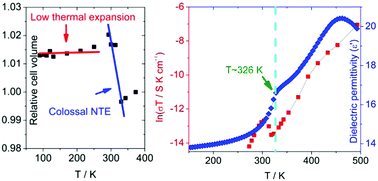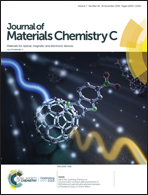Order–disorder transformation of intercalated cations triggering huge negative thermal expansion, switchable dielectrics and ion conduction near room temperature in a 2D vanadium oxide hybrid†
Abstract
Zero/negative thermal expansion (ZTE/NTE) materials are significantly desired in many applications; however, it is still a tremendous challenge to theoretically predict and successfully achieve new families of ZTE/NTE materials via rational structural designs. Herein, we present a new low-thermal expansion/NTE material, i.e. a lamellar vanadium oxide hybrid [C3H12N2][V4O10] consisting of mixed-valence {V4O102−}∞ monolayers and propane-1,3-diammonium cations in the interlayers. The inorganic layer is parallel to the (001) plane and comprises edge-sharing VO5 square pyramids linked together via corner-sharing VO4 tetrahedra. The hybrid shows a low thermal expansion coefficient (∼10−6 K−1) in the wide temperature range of 90–250 K and a colossal NTE (∼−600 × 10−6 K−1) between 293 and 330 K. Moreover, a reversible thermal anomaly occurs at ∼328/316 K upon heating/cooling, associated with a structural phase transition, which gives rise to switchable dielectric and ion-conducting properties; this study provides a new method for the exploration of lamellar vanadium oxide hybrids as new low-thermal expansion/NTE, switchable dielectric and ion-conducting multifunctional materials.



 Please wait while we load your content...
Please wait while we load your content...